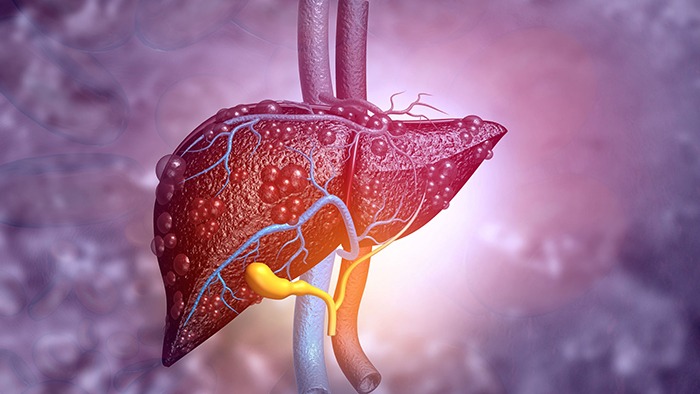The most important thing to recognize about liver disease is that up to 50 percent of individuals with underlying liver disease have no symptoms. The most common symptoms are very non-specific and they include fatigue or excessive tiredness, lack of drive, and sometimes itching.
Signs of liver disease that are more prominent are jaundice or yellowing of the eyes and skin, dark urine, very pale or light-colored stool, bleeding from the GI tract, mental confusion, and retention of fluids in the abdomen or belly.
The good news about the liver is that it has the ability to regenerate… under the right circumstances.
If you have NASH, you may have symptoms that could take years for them to develop. If liver damage from NASH leads to permanent scarring and hardening of your liver, this is called cirrhosis.
Cirrhosis often has no signs or symptoms until liver damage is extensive. When signs and symptoms do occur, they may include:
- Fatigue
- Easily bleeding or bruising
- Loss of appetite
- Nausea
- Swelling in your legs, feet, or ankles (edema)
- Weight loss
- Itchy skin
- Yellow discoloration in the skin and eyes (jaundice)
- Fluid accumulation in your abdomen (ascites)
- Spiderlike blood vessels on your skin
- Redness in the palms of the hands
- For women, the absence or loss of periods not related to menopause
- Confusion, drowsiness, and slurred speech (hepatic encephalopathy)

Heavy drinkers usually first develop symptoms during their 30s or 40s and tend to develop severe problems about 10 years after symptoms first appear.
Fatty liver often causes no symptoms. In one-third of people, the liver is enlarged and smooth but is not usually tender.
As alcohol-related liver disease progresses to alcoholic hepatitis, symptoms may range from mild to life-threatening. People may have a fever, jaundice, and a tender, painful, enlarged liver. They may feel tired.
Heavy drinking can make the bands of fibrous tissue in the palms tighten, causing the fingers to curl (called Dupuytren contracture), and make the palms look red (called palmar erythema).
Small spider-like blood vessels (spider angiomas) may appear in the skin of the upper body. Salivary glands in the cheeks may enlarge, and muscles may waste away. Peripheral nerves (nerves outside the brain and spinal cord) may be damaged, causing a loss of sensation and strength. The feet and hands are affected more than the upper legs and arms.
Diagnosis of Alcohol-Related Liver Disease
Doctors suspect alcohol-related liver disease in people who have symptoms of liver disease and who drink a substantial amount of alcohol. Doctors may give the person a questionnaire to help identify whether drinking is a problem. Doctors may also ask family members how much the person drinks.
There is no definitive test for alcohol-related liver disease. But if doctors suspect the diagnosis, they do blood tests to evaluate the liver (liver tests). A complete blood count to check for a low platelet count and anemia is also done.
Who’s at risk?

Health care providers don’t know the exact cause of fatty liver disease. But they think that obesity is the most common cause. Obesity in the U.S. has doubled in the last decade, and health care providers are seeing a steady rise in fatty liver disease. Although children and young adults can get fatty liver disease, it is most common in middle age.
Risk factors include:
- Being overweight
- Having high blood fat levels, either triglycerides or LDL (“bad”) cholesterol
- Having diabetes or prediabetes
- Having high blood pressure
Abstinence is usually the best treatment. Other than liver transplantation, abstinence is the only treatment that can slow or reverse alcohol-related liver disease. In addition, it is available to all and has no side effects.
Because abstinence is difficult, several strategies are used to help motivate people and to help them change their behavior. Strategies include behavioral therapy and psychotherapy (talk therapy)—often as part of a formal rehabilitation program—as well as self-help and support groups (such as Alcoholics Anonymous) and counseling sessions with the primary care doctor.
Therapies that explore and help people clarify why they want to abstain from alcohol (called motivational enhancement therapy) may also be used.
- A nutritious diet and vitamin

Supplements (especially B vitamins) are important during the first few days of abstinence. They can help correct nutritional deficiencies that can cause complications such as weakness, shaking, loss of sensation and strength, anemia, and Wernicke encephalopathy.
Supplements can also improve general health. Often, if inflammation is severe, people are hospitalized and may need to be fed through a tube to receive adequate nutrition.
- Benzodiazepines (sedatives)
These are used to treat withdrawal symptoms. However, if alcohol-related liver disease is advanced, sedatives are used in small doses or avoided because they can trigger portosystemic encephalopathy.

